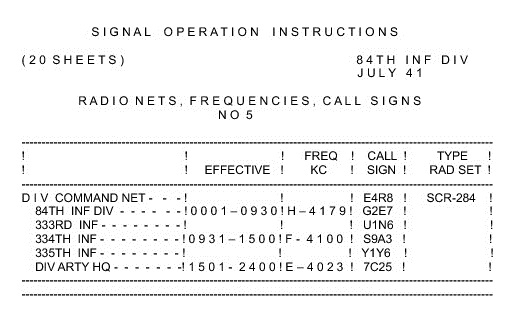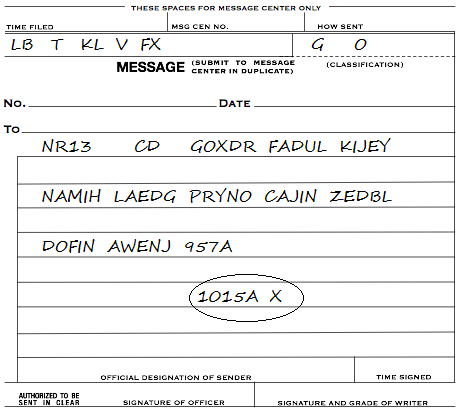The Radio Operator
Introduction
The Purpose of this manual is to provide a text for the training of radio operators and to establish an authoritative basis for coordination between all units of the Army in the use of radio procedure in the conduct of radio communication.The Call-up and answer
Call signs
All radio stations are identified by call signs, for example, WLW is the call sign of a broadcasting station in Cincinnati... Call signs for the various Army stations in field are normally assigned in Signal Operation Instructions (S.O.I) {A page of SOI below}.

The call-up
A station whose call sign is LB contacts a station whose call sign is LA by means of the "call-up":
__
LA V LB AR
In the above, V is an abbreviation for "from", and AR(upperlined)
means "end of transmission and statnding by to receive your reply".
{Author's note: the procedure signs which are upperlined, for example AR, correspond to characters which are transmitted in Morse without space, for example (for AR) ".-.-." instead of ".- .-.".}
If a called station fails to answer an initial call-up promptly, the call-up may be repeated immediately, with the call signs therein sent three times. If the second call-up is not answered, the calling station should wait at leat two minutes before transmitting a third call-up. Any additional call-ups necessary before receiving an answer should be at intervals of at least five minutes...
__
Original call-up-------------------------------: LA V LB AR
__
Second call-up--------------------------------: LA LA LA V LB LB LB AR
__
Third call-up, 2 minutes (or greater) interval : LA LA LA V LB LB LB AR
__
Fourth call-up, 5 minutes (or greater) interval: LA LA LA V LB LB LB AR
The answer
Station LA, upon hearing a call-up from LB, would answer by transmitting:LB V LA KK means "go ahead (transmit)".
Procedure signs
The abbreviations V, AR(upperlined), and K, which appeared in the above call-ups and answers, are three of a group of commonly used radio abbreviations referred to as "procedure signs." A partial list is given below:Procedure sign Meaning __ AR End of transmission. E E E E E E E E Error. Erase. ___ IMI Repeat. Question mark. K Go ahead. (Transmit.) V From. Calling. __ VA Finish.
Terminating transmissions
Some sort of terminating sign is necessary to indicate when the transmitting station cedes the air to the receiving station.a. AR(upperlined): "End of transmission" - This has the meaning, "I am through with this transmission, you may respond if a response is in order or necessary." Example:
__
LA V LB AR
Station LB has called up station LA with the intention of sending LA
something and now anticipates a "go ahead" sign from LA before
proceeding. Without the AR(upperlined) on the end, LA is not sure
whether LB has just paused briefly in his transmitting or is definitely
standing by wainting for LA to reply. The use of AR(upperlined) removes
this uncertainty.
b. K: "Go ahead, transmit. "- One station LA, having been informed that another station, LB, has something to transmit to LA advises LB to proceed by means of the terminating sign K, which means "Go ahead, transmit." LB might have advised LA of his desire to transmit something to LA by stating:
__
LA V LB AR
LA prepares his message form in anticipation of receiving a message
from LB and transmits:
LB V LA Kthat is, LA says to LB, in effect : "Go ahead, transmit. I am ready to copy."
c. VA(upperlined): "Finish". - VA is employed -
(1) To terminate a transmission to which an acknowledgment or reply is
prohibited or not expected, or:
(2) To indicate to the receiving station that henceforth until some
future time, the transmitting station will no longer be in
communication with the receiving station, as, for instance, should the
transmitting station be closing down to displace to a new position, or
closing down until the next regular operating schedule, or leaving the
net (by shifting frequency) to operate with a station in another net.
Procedure signs
a. R: "Receipt." - R is used to mean "receipt" of a preceding transmission, particularly one ending in K. For example, LA, having just received a message from LB, transmits:LB V LA RAs a simple acknowledgment of receipt, R may be used alone, as above.
The abbreviated form message
Form of message
Army radio messages are of two types. One, a "streamlined" style designed for speed in transmission of tactical messages, is known as the "abbreviated form". Its use is required within divisions and by smaller units and in all communications involving air elements. The other type of message, known as the "normal form", is designed for use by headquarters above division.Abbreviated form
The following is an example of an abbreviated form message with its various components labeled:
__
LA V LB T KL V FX G O BT DFC4 ALPX DGYR 923A K
call Retrans.instru. Special Classif. Break Text Time of origin Term.
The retransmission instructions to LA, viz., T KL V FX, are
interpreted: "Transmit the following to KL from FX". The special
operating instruction G means "Repeat back". The classification O
means "Urgent". The complete message above extends from the call to
the time of origin, inclusive. If, for instance, it is requested that
the message be repeated, everything shown above is repeated.
Copying and servicing {usage of M-210 form}
a. Copying. - Typewritten copy is made either five or ten groups to the line; penciled copy, five groups to the line. The receiving operator does not copy the complete call in a message as it is transmitted, but records only the call sign of the transmitting station. This information, together with retransmission and special operating instructions and the message classification, is entered on the message blank {i.e. M-210 form} at the top near the word "Message". Figure below shows the receiving operator's original copy of the message coreesponding to the following transmission:
__
LA V LB T KL FX FX G O BT
NR13 CD GOXDR FADUL KIJEY
NAMIH LAEDG PRYNO CAJIN ZEDBL
DOFIN AWENJ 957A K

{Author's note: the letter after the time indicates the time zone. the letter "Z" means GMT and letter "A" means the zone between 7.5E and 22.5E, i.e. the Europe. By default, it is the local time.}
The receiving operator copies all messages in duplicate. The first line of the text is copied on the line below the line beginning with the word "To." Succeding lines of text are copied on alternate lines of the message form to enable handling peronnel to read the text more easily. Unless otherwise specified in the text of the message, the writer and the addressee are indicated by the call signs of the station of origin and the station of final receipt and are the commanding officers {CO} of the units which these stations serve. The first group of the text, NR13, is a number group which is composed of the two letters NR and the number which the writer assigned to the message as a means for his future identification of the message.... The blank following "No" on the message form is for use with the normal form message only and is properly filled with a serial number assigned by the radio station of origin and serves as a means of future identification of the message for that radio station. The blank following "Date" on the message form is for use with the normal form message only and is filled with the date of the day on which the message was filed with the message center. This date when inserted as part of the heading of a normal form message is spelled out; for example, "Fifteenth," and the month and year are not written on the blank containing the message. The blank following "To" is reserved for use of the message center, as are also the blanks following "Time filed", "Msg Cen No," and "How sent" at the top of the message form.
b. Receiving operator's service. - The notation 1015A X is called the receiving operator's "service." X is the receiving operator's personal sign. 1015A is the time the message was receipted for by the receiving operator, that is, the time at which the message was considered as completely and correctly received. The receiving operator encircles his service as shown in figure above to indicate definitely that the service is not part of the text.
c. Transmitting opertor's service. - The transmitting operator services his copy of the message by entering the time of receipt and his personal sign at the bottom of the message. In addition he indicates the station to which the message was sent, in the event that his informaion is not already noted on the messsage blank.
A complete example (abbreviated form)
An Author's complete example (listen):The station LB want to send a message to station LA:
Station LB calls station LA:
__
LA V LB AR
Station LA is ready to receveive:
LB V LA K
Station LB:
(Station LB sends the message preceded by the header)
__
LA V LB O BT
NR13 CD GOXDR FADUL KIJEY
NAMIH LAEDG PRYNO CAJIN ZEDBL
DOFIN AWENJ 957A K
Station LA :
(the station LA aknowledges the message)
__
LB V LA R VA
The normal form message
a. General. - The normal form message differs from the abbreviated form message principally in that the former includes the additional features of a text group count (total number of groups in the text), a station-to-station serial number, and a date in the heading. A further distinction is the classifications of the messages. Abbreviated form messages are classified simply as either urgent (O) or routine, whereas normal form messages are divided into four groups : urgent (O), priority (P), routine, and deferred (D), in descending order of precedence.An Author's complete example (after the hand shake) (listen):
__
G2E7 V U1N6 NR2 210915 P GR-30 BT
NR3 VVPEO PLEIZ KXLMO JBLZD JWTEP NDPPH PNIZS XHJKN OFZVM
NXIMM YKINF BUHLR RRAFO GEBPP UPILX VNIIV ZGFDA CZWBY YLJVR
KGFVR WTBCK YIUAL PIYZC JDJCX JRYEM IHTXX VVPEO PLEIZ 0905Z
K
Commentary:
- G2E7 V U1N6
- Call
- NR2
- Station-to-station serial number
- 210915
- Date and time, here: 21 (of the actual month, July for example), 09:15 A.M.
- P
- Classification, here P=Priority
- GR-30
- Group count
- BT(upperlined)
- Break (end of header)
- NR3
- Writer's serial number
- VVPEO...PLEIZ
- The message ; here it is cryptographed by means of M-209. We use the setting of the manual TM 11-380, 1944. The indicator method used is described in TM 11-380, 1947.
- 0905Z
- Time of origin, 09:05 A.M., Z means GMT (Greewitch Mean Time)
- K
- Terminatting sign
References
- War Department - TM 11-454, The Radio Operator, April 21, 1942
- War Department - FM 24-5, Signal Communication, October 19, 1942
- Message Book M-210 - ilord NF6X